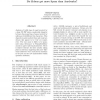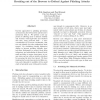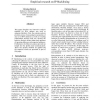CEAS
2008
Springer
14 years 1 months ago
2008
Springer
Human interpersonal face-to-face interaction can be considered in terms of successions of speech acts. These are utterances which contain an intention, and the act of creating an ...
CEAS
2008
Springer
14 years 1 months ago
2008
Springer
Analysis of traffic logs of email received by a large UK ISP shows considerable disparity between the proportions of spam received by addresses with different first characters. Th...
CEAS
2008
Springer
14 years 1 months ago
2008
Springer
Social networking communities have become an important communications platform, but the popularity of these communities has also made them targets for a new breed of social spamme...
CEAS
2008
Springer
14 years 1 months ago
2008
Springer
We consider activity-centered tasks in email, including the novel task of predicting future involvement of persons from an enterprise in an ongoing activity represented by a folde...
CEAS
2008
Springer
14 years 1 months ago
2008
Springer
Current approaches to phishing prevention are focused on the web browser and the user's interaction with it. We present a new approach to allowing users to interact reliably ...
CEAS
2008
Springer
14 years 1 months ago
2008
Springer
In this paper we consider the approach to image spam filtering based on using image classifiers aimed at discriminating between ham and spam images, previously proposed by other a...
CEAS
2008
Springer
14 years 1 months ago
2008
Springer
This paper describes two innovative analysis methods for IPv4 address sets such as antispam blacklists. First, the contents analysis provides means of measuring key properties of ...
CEAS
2008
Springer
14 years 1 months ago
2008
Springer
Over the past 5 years, spam sending technology has improved dramatically. Static messages sent opportunistically through misconfigured hosts have evolved into dynamically generate...
CEAS
2008
Springer
14 years 1 months ago
2008
Springer
Spam and phishing emails are not only annoying to users, but are a real threat to internet communication and web economy. The fight against unwanted emails has become a cat-and-mo...
CEAS
2008
Springer
14 years 1 months ago
2008
Springer
With the amount of unsolicited emails on the rise, domain authentication schemes have been widely deployed to identify senders. Establishing a sender's identity does not guar...



